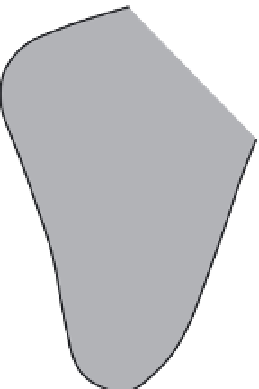Geology Reference
In-Depth Information
shield and the distinctive lower effective thick-
nesses in the western United States (Fig. 11.4).
Effective Elastic Thickness
Surface processes
To first order, landscapes subjected simply to
geomorphic processes tend to degrade through
time, high places losing material, low places
gaining. The specific processes and their rates
vary from climate to climate, and from one
lithology to the next. This general behavior can
be captured mathematically with the diffusion
equation, in which changes in the elevation of a
point depend entirely on the local curvature.
In other words, in one dimension,
32
16
128
64
8
4
2
∂
z
∂
z
(11.1)
=
k
∂
t
∂
x
2
where
x
is horizontal distance,
z
is elevation, and
k
is a landscape diffusion coefficient. The simplic-
ity of the diffusion equation is appealing, although
it is not without drawbacks. In particular, simple
diffusion-based models of surface processes gen-
erally ignore the need to produce regolith before
it can be transported (a problem only if the fea-
ture involves bedrock to begin with), and they
cannot account for channels in a landscape. In
addition, if we wish to explore the dependence
of the surface processes on climatic factors such
as precipitation or temperature, which change in
both space and time, we need to prescribe geo-
morphic rules that explicitly acknowledge these
dependences. The development of such rules is
evolving rapidly, as both field instrumentation
and dating methods allow documentation of these
spatial and temporal variations in process rates
(see, e.g., Dietrich
et al
., 2003; Roering, 2008).
Surface processes can be broken down loosely
into those that produce mobile material, or
regolith
, from intact bedrock (usually by the pro-
cesses of
weathering
), and those that move such
material about on the landscape (by transport
processes). At any point where the rate at which
the mobile material is stripped away outpaces
the rate of generation of mobile material, the
landscape will be bare bedrock. We refer to such
landscapes or points on the landscape as being
weathering limited
; the pace of weathering limits
Estimated Effective
Elastic Thickness (km)
8
Fig. 11.4
Effective elastic thicknesses across
North America.
Estimated distribution of effective elastic thicknesses
derived from analysis of gravity and topographic data.
Modified from Bechtel
et al
. (1990).
reviewed in Turcotte and Schubert (1982). For
two-dimensionally distributed loads, one must
turn to the solutions for a point load or disk
load (see, e.g., Lambeck, 1988; Watts, 2001).
Although these, too, are analytic solutions, the
flexural response to complex loads, i.e., those
that vary spatially in such a way that they cannot
be simplified into a simple symmetrical pattern,
is calculated by turning to a numerical code that
sums the vertical displacement associated with
each of many point or line loads. We show a
simple case employing the superposition of
many line loads meant to represent one or two
mountain crests (Fig. 11.3). Finally, one must
know something about the expected flexural
rigidity in a particular landscape. For example, a
map of the broad-scale features of the effective
thickness in North America, as estimated from
analysis of the gravity and topographic fields,
reveals both the strong rigid lithosphere of the













































